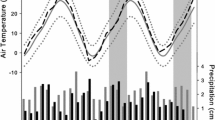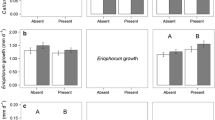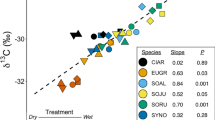Abstract
Poa secunda Presl. is one of the few native perennial bunchgrasses in the Intermountain West to persist and co-occur with the invasive annual Bromus tectorum L. following widespread overgrazing and frequent wildfires. To identify potential mechanisms responsible for the co-occurrence of P. secunda with B. tectorum, respiration rates (\(R_{\operatorname{CO} _2 }\)) of eight populations were measured at 10, 20, and 30°C on laboratory-grown plants by infrared gas analysis. In addition, \(R_{\operatorname{CO} _2 }\) and metabolic heat rates (q) of nine field-grown populations were measured at 10 and 20°C using calorimetry on eight dates over a growing season to compare temperature-dependent physiology of P. secunda with previous published patterns for B. tectorum. Laboratory respiration rates of P. secunda populations suggest considerable intraspecific variation in physiological response to temperature. Changes in slope for \(R_{\operatorname{CO} _2 }\) and q over the growing season were steeper at 20 than at 10°C , suggesting that P. secunda populations are more capable of maintaining steady rates of metabolism at low than at high temperatures. However, growth rates of P. secunda were relatively lower than those for B. tectorum at 10°C. Calculations of growth rates and efficiency of converting substrate carbon into biomass of P. secunda consistently remained positive, while those for B. tectorum rapidly declined at temperatures above 10°C. These data suggest that P. secunda co-occurrence with B. tectorum over a broad range of plant communities in the Intermountain West may be partially explained by having a similar ability to maintain positive and stable growth rate at low temperature. In addition, the greater ability of P. secunda to maintain growth rates and metabolic efficiency at higher temperatures than B. tectorum may allow this perennial grass to compensate for the greater relative growth rates of B. tectorum at low temperature.
Similar content being viewed by others
Abbreviations
- PPFD:
-
photosynthetic photon flux density
- q:
-
metabolic heat rate
- Q 10 :
-
respiratory quotient
- \(R_{\operatorname{CO} _2 }\) :
-
respiration rate
REFERENCES
Pickford, G.D., The Influence of Continued Heavy Grazing and of Promiscuous Burning on Spring-Fall Ranges in Utah, Ecology, 1932, vol. 13, pp. 159–171.
Mack, R.N., Invasion of Bromus tectorum L. into Western North America: An Ecological Chronicle, Agro-Ecosystems, 1981, vol. 7, pp. 145–165.
Billings, W.D., Bromus tectorum, a Biotic Cause of Ecosystem Impoverishment in the Great Basin, The Earth in Transition: Patterns and Processes of Biological Impoverishment, Woodell, G.M., Ed., Cambridge: Cambridge Univ. Press, 1990, pp. 301–322.
Link, S.O., Gee, G.W., and Downs, J.L., The Effect of Water Stress on Phenological and Ecophysiological Characteristics of Cheatgrass and Sandberg's Bluegrass, J. Range Management, 1990, vol. 43, pp. 506–513.
Wright, H.A. and Klemmenson, J.O., Effects of Fire on Bunchgrass of the Sagebrush-Grass Region in Southern Idaho, Ecology, 1965, vol. 46, pp. 680–688.
Daubenmire, R., Steppe Vegetation of Washington, Washington Agricultural Experiment Station Technical Bulletin, 1970.
Rickard, W.H., Vegetation of Knob and Kettle Topography in South-Central Washington, Northwest Sci., 1975, vol. 49, pp. 147–152.
Daubenmire, R., Annual Cycles of Soil Moisture and Temperature as Related to Grass Development in the Steppe of Eastern Washington, Ecology, 1972, vol. 53, pp. 419–424.
Hansen, L.D., Hopkin, M.S., Rank, D.R., Anekonda, T.S., Breidenbach, R.W., and Criddle, R.S., The Relation between Plant Growth and Respiration: A Thermodynamic Model, Planta, 1994, vol. 194, pp. 77–85.
Hansen, L.D., Taylor, D.K., Smith, B.N., and Criddle, R.S., The Relation between Plant Growth and Respiration: Applications to Ecology and Crop Cultivar Selection, Russ. J. Plant Physiol., 1996, vol. 43, pp. 691–697.
Criddle, R.S. and Hansen, L.D., Calorimetric Methods for Analysis of Plant Metabolism, Handbook of Thermal Analysis and Calorimetry, Kemp, R.B., Ed., Amsterdam: Elsevier, 1999, vol. 4, pp. 711–763.
Hemming, D.J.B., Meyer, S.E., Smith, B.N., and Hansen, L.D., Respiration Characteristics Differ among Cheatgrass (Bromus tectorum L.) Populations, Great Basin Naturalist, 1999, vol. 59, pp. 355–360.
McCarlie, V.W., Hansen, L.D., Smith, B.N., Monsen, S.B., and Ellingson, D.J., Anabolic Rates Measured with Calo-respirometry for Eleven Subpopulation of Bromus tectorum Match Temperature Profiles of Local Microclimates, Russ. J. Plant Physiol., 2003, vol. 50, pp. 183–191.
USDA, Soil Survey. Ada County Area, Idaho, Washington: US Department of Agriculture, Soil Conservation Service, 1980.
USDA, Soil Survey. Fairfield-Nephi Area, Utah, Washington: US Department of Agriculture, Soil Conservation Service, 1984.
SAS Institute Incorporate, SAS/STAT Users Guide, Release 6.03, Cary: SAS Institute Inc., 1989.
Criddle, R.S., Smith, B.N., and Hansen, L.D., A Respiration Based Description of Plant Growth Rate Responses to Temperature, Planta, 1997, vol. 201, pp. 441–445.
Ott, R.L., An Introduction to Statistical Methods and Analysis, Belmont: Wadsworth, Inc., 1993.
Morrow, L.A. and Stahlman, P.W., The History and Distribution of Downy Brome (Bromus tectorum) in North America, Weed Sci., 1984, vol. 32,suppl. 1, pp. 2–6.
Knapp, P.A., Cheatgrass (Bromus tectorum L.) Dominance in the Great Basin Desert, Global Environ. Change, 1996, vol. 6, pp. 37–52.
Arredondo, J.T., Jones, T.A., and Johnson, D.A., Seedling Growth of Intermountain Perennial and Weedy Annual Grasses, J. Range Management, 1998, vol. 51, pp. 584–589.
Hulbert, L.C., Ecological Studies of Bromus tectorum and Other Annual Bromegrasses, Ecol. Monogr., 1955, vol. 25, pp. 181–213.
Harris, G.A., Some Competitive Relationships between Agropyron spicatum and Bromus tectorum, Ecol. Monogr., 1967, vol. 37, pp. 89–111.
Aguirre, L. and Johnson, D.A., Influence of Temperature and Cheatgrass Competition on Seedling Development of Two Bunchgrasses, J. Range Management, 1991, vol. 44, pp. 247–354.
Author information
Authors and Affiliations
Additional information
__________
From Fiziologiya Rastenii, Vol. 52, No. 5, 2005, pp. 734–740.
Original English Text Copyright © 2005 by Monaco, Monsen, Smith, Hansen.
The text was submitted by the authors in English.
Rights and permissions
About this article
Cite this article
Monaco, T.A., Monsen, S.B., Smith, B.N. et al. Temperature-Dependent Physiology of Poa secunda, a Cool Season Grass Native to the Great Basin, United States. Russ J Plant Physiol 52, 653–658 (2005). https://doi.org/10.1007/s11183-005-0096-4
Received:
Issue Date:
DOI: https://doi.org/10.1007/s11183-005-0096-4




